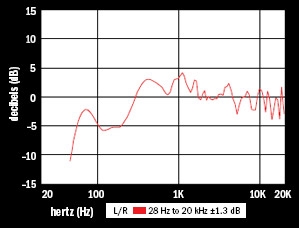Klipsch Icon XF-48 active stereo speakers. Page 2
In their final position, the XF-48s still came across a little warm, but the sound was open, balanced, and natural right across the midrange octaves. The top three octaves or so were more relaxed than I might have predicted, given Klipsch's tradition of crisp (even bright) voicing. But the treble was extended and generally well defined nonetheless.
This combination of sonic traits makes strings sound irresistibly gorgeous on the XF-48s. Case in point: the Smithsonian Chamber Players' Sony Classical/Vivarte recording of an octet by Louis Spohr (a much overlooked contemporary of Beethoven), with the Players on Stradivarius instruments from the museum's collection. Here, the sound was rich, rosiny, and generously detailed. It had a lifelike bite on strong attacks and a deep, resonant, woody sense of air around and behind each musician.
In today's multichannel age, it can be easy to forget just how much magic can be wrought by a single pair of speakers and a great stereo recording. Listening to the Reference Recordings disc of Eiji Oue conducting the Minnesota Orchestra in three works by Stravinsky refreshed my memory as to the depth, detail, and musical color that stereo can convey. The Icons performed admirably with challenging, full-range material like The Song of the Nightingale, producing smooth but exciting big-hall sound with ample slam on big-bass attacks.
So, do the XF-48s require a subwoofer? For most music listening, no. They produced, for example, the strong low "F" (43 Hz) on the opening notes of Feist's "Tout Doucement" without strain and with no loss of heft or loudness as compared to my everyday system, which includes a costly 12-inch sub. The speaker's low end was fairly even, moderately dynamic, and well defined, but with a touch of middle-bass emphasis that gave plucked jazz bass and similar instruments a warm, round tone.
The Icons could also play impressively loud. When I let loose with the 2002 remaster of Supertramp's Breakfast in America, I found that the speakers retained surprising punch and bass impact at fairly lease-breaking levels. When the Icons were pushed into rock-concert territory, dynamics began to flatten noticeably, and they became "shouty" in the vocal ranges, but they still didn't break up or otherwise overtly distort; this was well past the point I'd choose to undergo for more than 16 bars or so. Klipsch's rather terse specs volunteer only that each speaker's onboard wattage is "110 watts," and that its low-frequency amp is Class D (a "digital" amplifier) and the tweeter side is a Class A/B circuit. Whatever - I say it was enough.
MOVIE PERFORMANCE
In the name of science, I inserted the Icons into my multichannel layout, using my long-term center and surround speakers and amp. I then ran the system through a battery of film-sound hurdles from titles including Pearl Harbor and Master and Commander. Suffice it to say that the XF-48s delivered clear, punchy sound and plenty of output. They generated enough low-end grunt for satisfying movie sound, but for true high-end home theater, a subwoofer is certainly called for. Klipsch's XW-500d ($999), a compact 10-inch model, seems a likely candidate and will be available by the time you read this.
BOTTOM LINE
Klipsch's Icon XF-48 is an extremely able, extremely slim, and extremely good-looking powered speaker. And it's priced very fairly if you factor in the sums that would be otherwise spent on an external amp. Fans of serious sound who are unafraid to veer away from the passive-speaker herd - Icon-oclasts, if you will - should absolutely seek out the XF-48 for a listen.
 |
TEST BENCH
The curve for the XF-48 reflects response with the speaker standing on the floor, averaged over a ±30° window. All measurements were taken at a full 2 meters. This emulates a typical listening distance, allows larger speakers to fully integrate acoustically, and (unlike near-field measurements) fully includes front-panel reflections and cabinet diffraction. The primary characteristic of the XF-48 is a 6- to 8-dB reduction in response below 300 Hz and a series of narrow-band irregularities above 800 Hz that increase in severity and width with increases in frequency. When its Sensitivity adjustment is switched to Low, the speaker's basic level drops by 10 dB. - Tom Nousaine













































